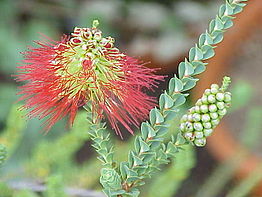Myrtaceae
The Myrtaceae (Myrtaceae) are a family of arboreal or shrubby plants, generally citric and aromatic evergreens, belonging to the order Myrtales. It consists of about 130 accepted genera —of which 25 are monospecific— and about 5,900 admitted species, of the almost 14,000 described. They thrive mainly in the Southern Hemisphere (especially Australia and tropical America), with a few representatives in other parts of the world, including Europe. The family includes exceptional plants, such as the tallest eudicots —110-140 m— on the planet (Eucalyptus) and specifically the most prolific genus —1200‒1800 species— that exists (Syzygium).
Description
There are such variations in size, leaves, flowers and fruits, that all descriptions at the family level have to remain practical generalities and, for finer diagnoses, refer to infrafamily descriptions, for example tribes and genera.
The family is made up of trees, shrubs or subshrubs, generally evergreen, which can reach considerable heights; trunk often has scaly bark that peels off in large irregular plates/flakes. Also, they are usually aromatic (canals or secretory blebs filled with essential oils —mainly terpenic compounds—) and, frequently, with scattered tanniferous secretory cells. The leaves, possibly heteromorphic, opposite or alternate, but rarely whorled, are characterized by their hyaline glandular points and are very variable, but always simple and entire, although seated or stalked and with or without stipules. The inflorescences are axillary or terminal, with an umbelliform or racemiform top, but they can also have solitary and/or axillary flowers. These flowers, often bibracteolate, are almost always hermaphroditic —but sometimes some are unisexual, as in Eucalyptus—, actinomorphic or, occasionally, zygomorphic, epigynous or perigynous to varying degrees. The perianth has an imbricated calyx with 3-10, usually 4-5 sepals, free or welded to the petals to form an operculum (calyptra) that detaches at maturity. The corolla, somewhat fleeting, has 3-6, generally 4-5 free petals or attached to the caliptra caduca. The androecium is constituted, in most cases, by numerous (20–150) stamens, rarely 5 or 10, free or united in 4-5 fascicles, with free filaments almost to the base, and sometimes with some staminodium; its anthers are ditheca, with longitudinal or foraminal dehiscence. The gynoecium has 2-5(6) carpels welded together with the ovary superior or more or less inferior —included in a more or less developed hypanthus—, with as many locules as carpels and axial placentation; but, sometimes, it is unilocular and of parietal placentation. The style is terminal and long, with a capitate or lobed stigma. The fruits are berries or loculicidal capsules and, infrequently, drupes. The seeds, winged or not, generally without endosperm, have a hard testa.
Distribution and habitat
- Distribution
- The representatives of the family are mainly from the temperate, tropical and subtropical regions of the entire South Hemisphere, with some other representative in the Mediterranean Basin to Transcaucasia to the east and the Sahara to the south. Due to its ornamental or economic/industrial interest, many species have been introduced outside their respective regions of origin; for example, rapid gender growth Eucalyptusso common and imposing in the landscapes of Mediterranean Europe. And a few others, less spectacular — but attractive — adorn urban and private gardens in many cities, for example Syzygium australe and the famous "limpiabotellas" or "limpiatubos" (diverse arbusive species of the genus Callistemon).
- Habitat
- The family has colonized virtually all habitats, except the northern and Arctic and the frankly southern ones, although they grow to Patagonia: from rainy tropical forests, to arid and desert areas, passing by mangroves, savannahs, dumped land and, for their eurasian species, Mediterranean shores.
Taxonomy
The family has been established, as "Ordo VII, MYrti, Les Myrtes", by Antoine Laurent de Jussieu and published in Genera Plantarum, p.322–323, 1789[2]. The type genus is Myrtus L. 1753[3].
Synonymy
The following synonyms are recognized:
- Baeckeaaceae Bercht. " J.Presl
- Chamelauciaceae Rudolphi
- Eugeniaceae Bercht. " J. Presl
- Heteropyxidaceae Engl. " Gilg in Engl.
- Kaniaceae Nakai
- Leptospermaceae Bercht. " J. Presl
- Melaleucaceae Vest
- Myrrhiniaceae Arnott
- Psiloxylaceae Croizat
Subdivisions
- Subfamily Myrtoideae Sweet, 1827
- Always opposite leaves; epigine flowers; berries or drupa fruits; especially in America.
- Tribes:
- Backhousieae Peter G. Wilson, 2005 (2 gene.)
- Chamelaucieae DC., 1827 (15-16 gene.)
- Eucalypteae Peter G.Wilson, 2005 (7 gene)
- Kanieae Peter G. Wilson ex Reveal, 2012 (8 gene.)
- Leptospermeae DC., 1827 (8 gene)
- Lindsayomyrteae Peter G.Wilson, 2005 (1 gene)
- Lophostemoneae Peter G.Wilson, 2005 (4 gene)
- Melaleuceae sensu Wilson " al., 2005 (9 gene)
- Metrosidereae Peter G.Wilson, 2005 (1 gene.)
- Myrteae DC., 1827 (52 gen.)
- Osbornieae Peter G.Wilson, 2005 (1 gene.)
- Syncarpieae Peter G.Wilson, 2005 (1 gene.)
- Syzygieae Peter G.Wilson, 2005 (1 gene)
- Tristanieae Peter G.Wilson, 2005 (3 gene.)
- Xanthostemoneae Peter G.Wilson, 2005 (3 gene.)
- Subfamily Psiloxyloideae R.Schmid, 1980
- Opposite or alternate leaves; epigine or perígine flowers; capsule fruit; almost exclusively in Australia.
- Tribes:
- Heteropyxideae Harv., 1868 (1 gene.)
- Psiloxyleae A.J.Scott, 1980 (1 gene)
Genres
See: Annex: Accepted genera (and their eventual synonyms) of the Family Myrtaceae (Order: Myrtales) Eucalyptus, Callistemon, Eugenia,
Cytology
The most common number of chromosomes in the whole family is 2n=22, although much lower numbers are also known —up to n=5— and cases of diploidy and polyploidy —22-88— at intra and interspecific level.
Contenido relacionado
Coelorachis
Brachyelytrum
Beta sheet
